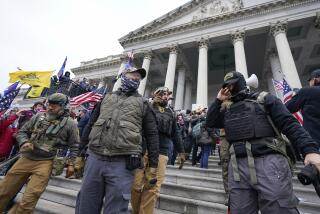Long Memories, but Sandinistas OK Pardons
MANAGUA, Nicaragua — When the Sandinistas seized power in a popular uprising, Juan de Dios Herrera was a 23-year-old sergeant in the Nicaraguan National Guard. Convinced that he had served honorably, he shed the uniform of defeat and went home looking for work. But he misjudged the mood of the victors.
As President Anastasio Somoza and about half the guard fled Nicaragua in July, 1979, Herrera, like thousands of others, stayed behind and ran afoul of revolutionary justice. He was arrested and convicted of being on the wrong side of the celebrated battle of Monimbo, where 11 Sandinistas including Camilo Ortega, the current president’s brother, were killed.
Despite conflicting testimony as to whether he was even in the town, Herrera received the maximum 30-year prison sentence.
The Sandinistas’ long memories of their martyrs and broad definition of guilt for their enemies have made those trials a never-ending controversy. Former guardsmen and others who became Contras in order to struggle against the leftist Sandinistas demanded amnesty in the name of national reconciliation, while many Sandinistas resisted such a step as contrary to revolutionary principle.
On Tuesday night, the Sandinista-controlled National Assembly moved to bury the issue by voting pardons for all but 39 of the 1,933 guardsmen still in prison, under house arrest or on parole. Those covered, including Herrera, are expected to be freed Sunday in the largest prisoner release in two Nicaraguan wars spanning more than a decade.
First Step Under Peace Accord
The pardons are the first step in carrying out President Daniel Ortega’s month-old commitments under a new Central American peace accord, which also calls for legal changes to ensure fair and open elections in Nicaragua next February. In return, the region’s four other presidents agreed to help draft by mid-May a plan for closing the Contra camps in Honduras.
In an emotional speech to a rally last month, Ortega said he had agreed to free his brother’s killers in the hope of stopping further bloodshed in the Contra war. “Although the heart resists and says no,” he said, “reason tells us yes, it is the correct thing to do.”
However, weeks of intense debate on the issue have reopened old wounds and stirred a new dispute. In what appears to be a violation of the summit accord, the Sandinistas used political standards as well as legal ones to keep the last 39 guardsmen in prison.
In a country where nearly every family has lost someone to war, any kind of forgiveness is an extremely delicate issue, and Ortega’s appeal was met by an outcry of Sandinista protest. As a result, the government backed away from previous pledges of amnesty, which would have legally erased the guardsmen’s criminal records, and offered only pardon.
“Amnesty means forgetting,” said Interior Minister Tomas Borge. “The revolution pardons but never forgets.”
To emphasize that point, Sandinista television has begun airing 10-year-old newsreels of guardsmen breaking into homes and dragging out Sandinista suspects whose bodies are later shown piled in the streets. The propaganda has alarmed guardsmen’s relatives.
“On one hand, I feel happy that a great injustice is ending,” said Rosa Maria Herrera, the former sergeant’s sister, whose husband, brother-in-law and two cousins are also covered by the pardon. “But the climate is really ugly. My brother was tortured in prison. What happens if he runs into his jailers in the streets?”
The National Guard was created with U.S. assistance in 1927 and became a pillar of the Somoza family dictatorship, which endured more than four decades. According to the Red Cross, at least 10,000 Nicaraguans, most of them civilian victims of the guard, died in the heaviest fighting of the Sandinista uprising, between September, 1978, and July, 1979. Many officers blamed for atrocities fled to Honduras, the United States or El Salvador as their army collapsed.
Some people feared that guard soldiers left behind would be summarily executed. Instead, tribunals were set up to judge 6,310 Somoza-era officials, most of them guardsmen or informers. According to the government, 4,331 were sentenced to prison by February, 1981.
A small number were convicted of specific crimes. Others were found guilty of so-called war crimes, such as bombing civilian areas. But as no direct evidence existed against most of the guardsmen, they were convicted of illicit association and membership in a “criminal organization.”
A critical report in 1981 by the Inter-American Human Rights Commission said most of the tribunals were made up of Sandinista militants with a desire for revenge and no legal training. The trials lacked constitutional safeguards and stretched the rules of evidence. Applying a concept called “criminal geography,” for example, a court could convict a guardsman who had been serving in an area where a war crime occurred, without proving that he took part.
Ortega acknowledged that many guardsmen were jailed unfairly “because of haste in the application of justice.” Last March, in a truce agreement with the Contras, his government agreed to free most guardsmen once a final cease-fire was signed.
Under the agreement, the inter-American commission was asked to review the trial records of all imprisoned guardsmen and determine who should remain behind bars. In an unpublished report last spring, the panel said it found credible evidence of specific crimes against fewer than 50 guardsmen.
The report was not binding because the truce broke down. Last month’s summit accord obliged the Sandinistas only to free guardsmen “in accordance with the classification made by the commission”--meaning they could use the commission’s criteria but decide for themselves whom not to pardon.
However, the Assembly committee assigned to the task added a new classification. Instead of excluding only guardsmen with legally founded guilt, as the inter-American panel had done, it recommended disqualifying 27 others, most of them high-ranking guard officers, for refusing to take part in prison “re-education” programs.
Sandinista lawmakers said that freeing such unrepentant guardsmen might pose a danger to society. But Cesar Augusto Castillo, a conservative, said the ruling party needed “a permanent museum of symbolic guard officers” to satisfy its hard-liners. He told the Assembly at least 10 of the 27 were “completely innocent” of any charges.
“The National Guardsmen were condemned by the people before they ever got to trial,” retorted Sandinista Assemblyman Gustavo Vega. “If we are pardoning most of them now, it is not because they are innocent but because we have to take arguments away from those who want war.”
The pardons were approved in a unanimous vote after legislators of the small Popular Action Movement walked out. The Assembly rejected a motion by that Marxist group to delay the pardons until the Contra camps are closed.
Even while voting for the pardons, many lawmakers criticized the proposal. Some in the opposition warned that the Contras will never lay down their arms unless pardons are extended to the 2,000 or so jailed Contra supporters.
“As long as the Contras are still in their camps, what is the guarantee that these pardons will contribute to peace?” asked Sandinista lawmaker Danilo Aguirre, who lost a son in the uprising.
In a separate motion, the Assembly said pardons for the 39 guardsmen still in jail can be reconsidered when the government moves to free the jailed Contra supporters, a step that Ortega said must wait until the rebels start disarming.
Those denied pardons include guardsmen accused of killing Borge’s wife, torturing Doris Tijerino (now the national police chief), pistol-whipping Daniel Ortega in a pool hall and slaying 8-year-old Sandinista gunrunner Luis Alfonso Velazquez, official martyr of the Sandinista Children’s Assn.
More to Read
Sign up for Essential California
The most important California stories and recommendations in your inbox every morning.
You may occasionally receive promotional content from the Los Angeles Times.










